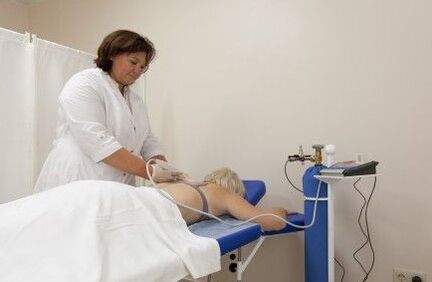Osteochondrosis of the cervical spine is a very common disease against which dystrophic changes in the cartilaginous tissue, between the vertebrates and the bone basis. This pathology develops in many people who have reached the age of 30. Symptoms of cervical osteochondrosis are varied, so it is quite difficult to diagnose the disease and choose the right treatment.

Factors that provoke the appearance of the disease
Cervical osteochondrosis may develop under the influence of the following factors:
- Excessive weight;
- Tempting labor, inaction;
- Prior to spinal column injuries;
- Mental disorders, nervous excessive, stress;
- Bad physical exercise;
- Spine curve, scoliosis, improper posture;
- The wrong position of the body that has become a habit;
- Tension in the neck, during surgery;
- Prone to genetic level;
- For the body of unusual physical stress, increasing activity;
- Inal meal.
The cervical region of the spine is subject to increased load, which the cervical muscles of the cervix try to cause equilibrium to lead to the influence of the above sources. This results in the appearance of muscle spasms, which is why there is blood transport throughout the body. As a result, the formation of anatomical injury is noted.
The degree of osteochondrosis
During the development of cervical osteochondrosis, the discs between the vertebrates are weakened, causing the discs, vertebrates, articular tissue of the cervical region. The first degree of disease is almost asymptomatic, as the cartilage changes only begin. In this case, the person complains of appearance:
- Headache;
- Discomfort in the neck, arms, shoulders;
- Minor restrictions on neck motor action;
- Short -term impairment of visual function;
- Reduce sensitivity to the collar zone.
The second stage is sometimes accompanied by a small spine hernia, as well as narrowing between the spine. Due to the disruption of nerve receptors, there is a feeling of pain in the process of movement. In the light of a second degree of disease, the patient notes the appearance:
- Pain syndrome on the neck, head movements.
- Loss of skin sensitivity around the arms and shoulders;
- Reduction of visual function;
- Call ears;
- Bumps on the face and neck;
- Weaknesses in the hands;
- Shooting pains in the shoulder blade;
- Disorders in sleep function.

It is very difficult to treat osteochondrosis of the third degree cervical region. At this time, the hernia develops, with deformed spinal column, position changes, dislocation in the ridge elements. At this stage of the disease is accompanied by:
- Expressed pain in the neck, myocardium, collar area;
- Lack of skin sensitivity to the head, arms and shoulders;
- Paralysis of hands;
- Lack of tendon reflexes;
- The hernia formation in the cervical spine.
In the process of the fourth (final) stage, the marks are exacerbated.
Symptoms
Signs of neck disease are significantly different from the symptoms of osteochondrosis in the other side of the spine.Once the cervical vertebrates are located near, the nerve roots and the spinal cord are cut. This causes such signs to appear:
- Pain syndrome is localized to the neck, shore, shoulders, arms and legs. When nervous receptors join, the shoulder zone appears unpleasant sensations, on the back, the hands begin to recover. Due to spasms in the cervical muscles, blood circulation disrupts.
- There is a case of weakness in the upper extremities associated with damage to the functioning of the roots, which contributes to the involvement of motor nerves that restore muscle tissues in the hands.
- The upper extremities are restored due to a decrease in sensitivity in them, the root disorder in which sensitive nerve endings are located.
- When the head is turned, the painful sensations arise, and you can also hear the crisp. This is explained by injury to the small joints of the cervical region, a decrease in intervertebral discs.
- The patient complains of insufficient strength, fatigue, dizziness, coordination disorders. Due to the movement of the elements of the spine, the spine is contracted. Because of this, blood circulation will deteriorate, causing blood supply to the core section and cerebrum.
- Appearance of vision problems, loss of sensitivity to the tongue.
Symptoms of cervical osteochondrosis in women are no different from signs in men. Women who have achieved 45 -year -olds and older women who have been diagnosed with such a disease indicate numbness and contamination in the upper extremities in a dream.
What is the danger of osteochondrosis of the cervical region
The disease can harm the body as a whole. The neck is located in a significant amount of arteries, nerve receptors, blood vessels through which the brain is supplied. If even a minor disease occurs, they will contract.This results in problems with blood supply to the brain.As a result, migraine formation, cardiac rhythm disorders, respiratory and visual problems are noted, as well as impaired coordination and attention.
Against the backdrop of osteochondrosis of the neck, such diseases can occur:
- Pathologies in the brain;
- Arterial vessel syndrome of the spine;
- Spinal stroke.
The most severe complication is the patient's death, which can occur when spraying the spinal canal. Symptoms and treatment of cervical osteochondrosis are caused by the stage of the disease.
Therapeutic actions for cervical osteochondrosis
Cervical spine osteochondrosis is prescribed, despite the patient's sexual sex. Treatment is carried out in several stages:
- Removal of painful manifestations.
- Eliminate swelling.
- Blood circulation to the norm.
- Muscle fix on the back, abdominal press, chest.
- Improvement of nutrition quality and tissue spine regeneration.
If there are even minor signs of the disease, a specialist should be consulted. An integrated approach is used with such a pathology, a surgery, neuropathologist, physiotherapist and manual therapist.
For therapeutic purposes, cervical osteochondrosis, medication, physiotherapeutic treatment, collar massage and physiotherapy exercises are used as it is quite effective in this condition.
Medicines
When osteochondrosis of the neck, they are prescribed:
- Preparation for eliminating muscle spasms;
- Vitamin Tools to improve metabolic processes in the central nervous system;
- NSAID group medications to reduce pain, eliminate inflammatory process and swelling;
- Joint joints, cartilage restoration contribution, elimination of disorders between the spine.
- Medications that are favorable to improve the nutrition of the affected nerve tissue, regulate blood flow transportation to the brain.
First aid for exacerbation of cervical osteochondrosis
Sometimes, if the pain syndrome becomes unbearable, but it is impossible to see a doctor, experts recommend taking analgesics. To facilitate the pain, you can seek the help of a "pepper patch", but this device only brings a short time to release.The patch will help warm the affected area and relieve the pain for a while.To prevent swelling, use of herbal infusions is recommended for 3-4 days.
But it should be borne in mind that it will not work for use from cervical osteochondrosis using such methods. These methods help to cope with signs of the disease for a short time. To determine full therapy, you need to contact a specialist.
Physiotherapeutic procedures
As part of a complex treatment to improve the effect, use:
- Electrophoresis - Analgesic medicine ions penetrate the affected side due to the electrical current effect. Novocaine or lidocaine is usually used during the procedure.
- Laser Therapy - It has anti -anti -action action, improves blood circulation through the influence of light.
- Magnetic Therapy - Helps get rid of swelling in tissues, has an analgesic effect.
- Ultrasound - Helps improve metabolism, anesthesia, removes the inflammatory process in the affected side.

Medical physical education
Also, with cervical osteochondrosis, therapeutic exercises will help improve well -being. It is noteworthy that exercises should not be accompanied by pain or discomfort. Exercise Complex:
- We sit on our stomach and rest on the floor. The backs should be equal, and the head and body grow. We spend about 2 minutes in this position, then return to its original state. We finish 2-3 repetitions.
- We lay on the floor, lying on your back, from your arms along the body. We head to the right to the right first, trying to touch the floor of the ear. We do exercises 6-7 times in each direction.
- We sit on the floor. We breathe and move forward to touch the chest. To remove it, we were back to you. The exercise should be repeated 10-15 times.
- We sit on the floor, press your hands on the forehead and at the same time we dropped it on top. Exercise should be done for about 30 seconds, repeated 2-3 times.
- Slowly, slowly, we spin on the heads so as not to cause dizziness. When the head begins to dizzy, the exercise should be stopped. It is necessary to rotate 10 times, then to the right.
Home treatment
Such therapy can only be used as part of a comprehensive treatment prescribed by your doctor.At home you can seek help from folk remedies, physiotherapy and massage.
You can use the following recipes with cervical osteochondrosis:
- Put the horseradish sheet on the mud and fix with a bandage or cloth. The sheet should be poured into hot water and then cooled to room temperature. Such a bandage is placed before bed and left until morning.
- Grate the potatoes and mix with honey in equal proportions. Apply to the compress every 7 days.
- In order to weaken the pain, warming will help with mustard, sand bag, pepper patch, etc. Sh.

Before using all joints, it is advisable to consult a doctor.
Massage
Medicinal massage can be performed at home. You need to start in a healthy area of the body, gradually moving to the affected side. The massage complex should be selected based on the individual characteristics of the patient, with the degree of neglect of the disease. The massage should be performed by the patient, horizontally placed on the floor. You need to place your palms on the forehead, and my chin aspires to the chest. Neck muscles should be relaxed.
The massage is carried out as follows:
- First the collar zone with massage movements.
- Then go to weaken. To do this, your hands went around the neck and move along the spine. Also, this technique can be used during shoulder massage.
- To heat the neck muscles, we drink it. This will help the body relax, improve blood circulation. You have to move the skull along the spine using circular movements.
- The last movement is a vibration that is carried out thanks to the replacement and shaking.
Preventive actions
To prevent the development of cervical osteochondrosis, it is recommended:
- Sport (an ideal option is to visit a basin).
- Include products rich in calcium and magnesium in the diet.
- Wash it several times a day, especially when the session is busy.
- According to the requirements, change the pillow (buy low) and mattress (quite difficult). In a dream, follow the neck of the neck: The neck should be at least 15 degrees.
- Take a hot shower for at least 10 minutes throughout the day.
- People who do not welcome sports recommend that they recommend periodically attending the yoga department.
- Do not get involved in simulators, as this can lead to deterioration of well -being.


























































































